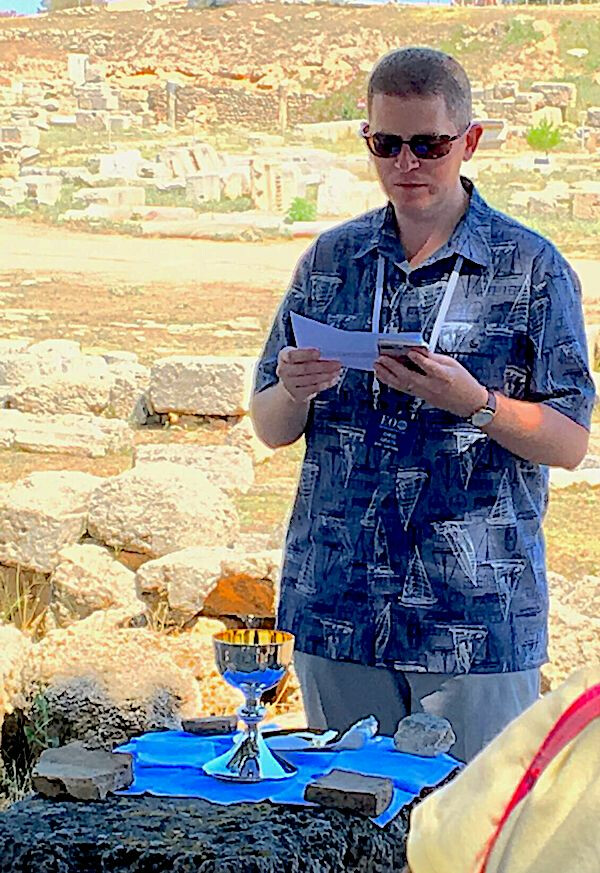Pilgrimage Tracing St. Paul's Missionary Ministry - A Pilgrim's Perspective
One traveler described it as the “trip of a lifetime”– the opportunity to retrace the Journeys of Paul as part of a July pilgrimage led by Rector Chris Girata. On the 13-day Mediterranean cruise, Saint Michaelites not only learned about the Apostle Paul, the great evangelist and church planter, but also soaked in myriad examples of early Christianity in the Greco-Roman world.
The most Paul-intensive venues were Rome, Athens, Corinth and Malta. Ephesus, where Paul wrote his first letter to the Corinthians, was removed from the itinerary after a state department advisory on travel in Turkey.
Before the trip, we prepared by reading the Book of Acts and a study guide. Onboard, our extended group, including new friends from other churches, heard presentations by New Testament scholar and seminary professor, Dr. David deSilva. Even more meaningful to us was the regular shipboard gathering of the Saint Michael family -- parishioners, their guests and the extended Girata family – for Q&A and discussion with our rector.
At the first “circle-up”, the Rev. Dr. Girata emphasized: “I want this to affect your life after you go home.” For that to happen, we needed to see how difficult the groundbreaking journeys were for Paul and how important they were for Christianity today. As the Rector said, “Paul gave up everything to simply tell people about Jesus.”

The importance of Paul was not only that he created communities of Christians through his evangelism but he also built the structure of the church with his letters. Paul was an educated Jew, chosen by God to spread the word of Jesus after his Damascus conversion. As the Rector explained, Paul spoke several languages; he could speak, write, and unite people. But it was far from easy, as our trip reinforced. In Rome, Paul spent two years under house arrest at the end of his third journey and wrote the letters to the Ephesians. We saw from afar the Church of St. Joseph of the Carpenters, built over the jail where Peter and Paul were imprisoned. At the Coliseum, we viewed the large cross commemorating the persecution of Christians before Constantine legalized Christianity in 313 AD. Despite shoulder-to-shoulder tourists, we collectively experienced the extensive religious art at the Vatican, sharing the Creation frescoes of Michelangelo in the Sistine Chapel. A highlight was the celebration of mass by our group in St. Peter’s Square. We dined together. We hiked in the heat together. We laughed together and we learned together.
In Athens, we saw where Paul shifted from preaching to Jews to Gentiles. The hardy souls on our trip climbed to Mars Hill where Paul preached to the learned Athenians for the first time, then on to the Acropolis, the city’s highest point. Our tour guide said Paul reportedly won only a few converts in Athens but he sowed the seeds; today Greece is 90 percent Christian.
Corinth offered a spiritual high as we walked where Paul walked, preached, and was arraigned in 52 AD. We celebrated the Holy Eucharist among those ruins. Paul lived in Corinth for 18 months and planted the first church there aimed at Romans, or Gentiles. Corinth was a crossroads, controlling access to two bodies of water and ancient roads. It was a political, social, and trade center and site of the Corinthian games – no doubt offering Paul the opportunity to ply his trade as a tentmaker and to preach to residents and visitors. Raising up a church in such an affluent environment was challenging. As the Rev. Dr. Girata explained: “Corinth was a rich city. It was hard for them to embrace Christianity because it calls for sacrifices and to do for others and not just for ourselves.” It was a challenge that we, as pilgrims, recognized today.
We found Malta dotted with remembrances of Paul – including St. Paul’s Bay, St. Paul’s Island, and St. Paul’s Cathedral, founded in the 12th Century in the walled city of Mdina. While traveling from Jerusalem to Rome to face trial, Paul’s boat was shipwrecked near the island. Paul survived a snakebite, holed up in a cave, healed the sick and evangelized for a few months. That cave became an early place of Christian worship and is now a shrine, St. Paul’s Grotto, over which another St. Paul’s Church was built. Paul was the first Christian on Malta, known for the Knights of Malta and the Maltese cross, and Christianity thrived there. We also enjoyed the popular Greek islands of Mykonos and Santorini, featuring spectacular vistas of blue-domed churches, whitewashed structures, azure waters, and hundreds of family chapels. Donkeys and cable cars transported people to the highest Santorini villages. Our tour guide said the island is reputed to have “more wine than water, more churches than houses and more donkeys than people.” Our group seemed to prefer the wine to the donkey transport. In his final onboard lecture, Prof. David deSilva encouraged us to think about how rigorous Paul’s ministry was and how committed he was in the face of difficulty. Referencing Psalm 116:12 (How can I repay the Lord for all his gifts to me?), DeSilva said: “In everything that you do, think how can I give back to God what he has given me.” Brayden Girata, the 11-year-old son of Chris and Nicole Girata, allowed as how the best part of the trip was “being together with everybody.” To be sure, each of us relished that sense of togetherness and returned energized in our faith and committed to having it impact our lives, to embracing the new Plus One program, as we build the community that is Saint Michael and All Angels.
For a more detailed version of our journey, read the Rev. Dr. Girata’s day-by-day blog on saintmichael.org.

